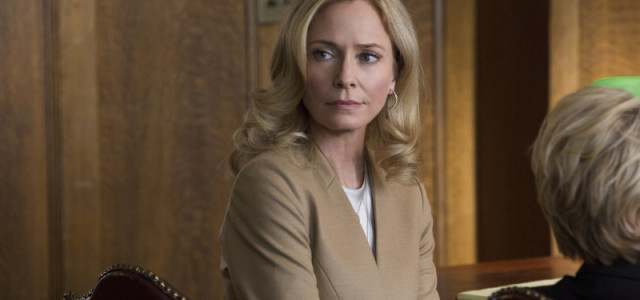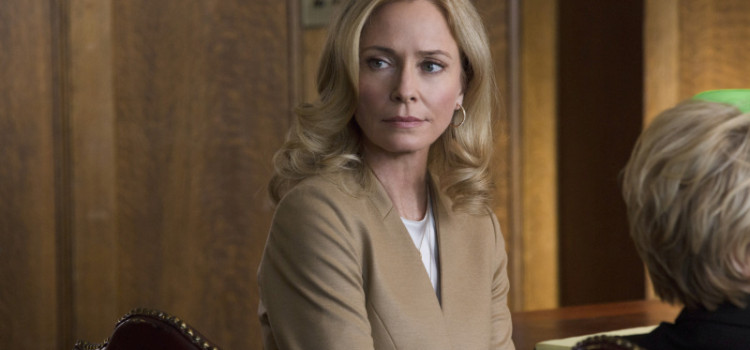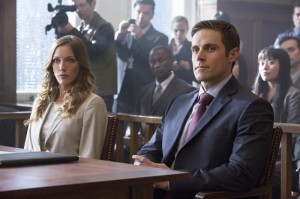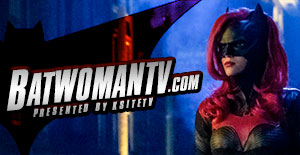

Arrow #2.7: “State v. Queen” Recap & Review
Recaps & Reviews November 25, 2013 Matt Tucker

 Summary: A seemingly standard yet deceptively strong episode that’s taste needs to marinate to fully appreciate. The dense hour is full of surprises and heavy on new plot twists.
Summary: A seemingly standard yet deceptively strong episode that’s taste needs to marinate to fully appreciate. The dense hour is full of surprises and heavy on new plot twists.
If you have not seen this episode yet and do not wish to be spoiled, do not continue reading!
Recap
Moira’s trial gets underway and ADA Donner is confident he’ll win, possessing evidence he feels will punch holes in Moira’s defense. Thea testifies and is grilled by Donner over the fact that it took her five months to visit her mother in prison because she blamed her mother for what happened during the Undertaking. Jean Loring pushes Moira into testifying on her own behalf to help humanize her. After Diggle falls in to what seems like a flu, Felicity discovers that he was dosed with a new version of the drug Vertigo. Team Arrow finds that the Count escaped from Iron Heights just as the Dollmaker had during the Undertaking. Back on the streets, Count Vertigo now plans to infect the city with his Vertigo-laced virus, forcing all of the citizens to go into withdrawal symptoms and demand the drug from him to ease their pain. Donner falls victim to the virus and is captured by the Count to make an example. With Donner down, Laurel is forced to take over. Learning of the evidence against Moira, Laurel meets with her to ask her not to testify. Moira decides to take the stand anyway, and Laurel reveals that she had engaged in a one-time affair with Malcolm Merlyn, suggesting that Moira had greater influence over Malcolm and didn’t have reason to fear for her or her family’s lives as her defense claims. Felicity and Diggle track the pattern of the virus outbreak to mobile flu innoculations. When Felicity goes to investigate, she is captured by the Count, who determines that the Arrow is Oliver Queen. Count Vertigo holds Felicity hostage in Oliver’s office and demands Oliver come to him, revealing that he was hired to take the Arrow out. When he endangers Felicity’s life, Oliver is forced to take the Count out for good. Now, with a sample of the virus available, Felicity is able to have Queen Consolidated develop an antigen. The jury comes back on Moira and she is acquitted of all charges. Free and on the drive home, Moira is instead taken to a vacant parking lot where she is confronted by the very much alive Malcolm Merlyn. He reveals that he pulled strings to get the verdict at her trial because he learned the truth about Thea Queen; she’s his daughter. In the past, Ivo and the Amazo crew take Oliver back to the island to find the cave with the Japanese soldiers. The first go to the plane wreckage to kill Slade and Shado, but they are missing. At the cave, Ivo finds that the hosin is missing. Outside, they are confronted by Shado and Slade. The two help Oliver escape, and he grabs Sara during the fray. Once away from the Amazo crew, Sara divulges that the Japanese submarine they are looking for houses a super soldier serum. Oliver wonders if the serum could help the now disfigured Slade.
For a full recap of this episode, visit our handy episode guide.
Review
In our best Brian Blessed-as-Prince Vultan voice: “MALCOLM’S ALIIIIVE!”
It was the outcome we predicted in immediate response to last year’s finale and even guessed at early into the season last year. You can’t keep a good villain down, and the mere mention of Nanda Parbat by Malcolm in “Dead to Rights” conjured up connections to Ra’s al Ghul and possible stabs at immortality. Now, there are a multitude of possibilities to his implied “resurrection” — we can specubate below — but suffice it to say that having John Barrowman back is a wonderful thrill.
 Amongst the talk in the fandom this season, there have been open suggestions and speculations that Thea was Malcolm’s daughter. That made the reveal not that surprising, and yet that also made a distinctly soap operatic development resonate more honestly. (Though, let’s be clear whenever the term “soap opera” is thrown around about a superhero show on the CW, usually in disparaging fashion; superhero stories are soap operas. They always have been. Actually read the comics and you’ll find many of the same tropes.) It fits.
Amongst the talk in the fandom this season, there have been open suggestions and speculations that Thea was Malcolm’s daughter. That made the reveal not that surprising, and yet that also made a distinctly soap operatic development resonate more honestly. (Though, let’s be clear whenever the term “soap opera” is thrown around about a superhero show on the CW, usually in disparaging fashion; superhero stories are soap operas. They always have been. Actually read the comics and you’ll find many of the same tropes.) It fits.
Some wonder if this might lead Thea down a dark path at some point, and it’s certainly possible. Lest we forget that her source inspiration was a prostitute who lived a pretty desolate life until Oliver took her under his week. (She also had the misfortune of contracting HIV.) Nobody is expecting these specific things with Thea, but family legacies play a big part in comics and in Arrow. Still, with Roy offering himself up as punching bag as a way for Thea to channel her anger, we might just be seeing the beginnings of her own Speedy path to herodom.
The long-awaited trial of Moira Queen gets underway, and like that – poof – it’s gone. It’s hard to tell whether to be thankful or disappointed. In real life, a trial like this would likely last weeks, if not longer, and while time does pass over a few days here, it all feels rather short and quick. In a certain sense, it’s somewhat anticlimactic in that the set-up over the past few weeks of Moira’s dark past doesn’t entirely pay off. Sure, the affair with Malcolm is a whopper and does directly affect her claims of being forced to cooperate with him out of fear. Yet, the impression left in the set-up was of a string of indiscretions that would’ve painted Moira far more guilty than she would’ve liked. In the end, Moira really was just caught in a particularly tough situation. While the Thea revelation will have long-lasting implications, and there is sure to be mileage gotten out of people questioning just how she was able to beat conviction by a jury when her trial was pretty well stacked against her, it’s a bit murky to see how relevant a character Moira is going forward. Though, we shall enjoy Susanna Thompson while we’ve got her.
Not going forward is the Count. Barring interference by any of the serums or formulas that have slyly become the running theme of this season — those that offer super strength, regeneration, invulnerability, and all manner of assorted special abilities — seeing an actual lifeless body for the character, both at the time and in the aftermath on the news, seems much more definitive than Malcolm’s previously assumed end. There’s a degree of sadness to this development; Seth Gabel is a fun presence who chewed up scenery. There’s also a degree of inevitability. Oliver had already been faced with the dilemma of choosing between killing or sparing the Count twice before. They’d also pushed the Vertigo drug story about as far as it could go without seeing like retread. Once it was revealed that Count Vertigo had learned the Arrow’s secret identity, it was all but guaranteed that Oliver was going to be pushed into taking another life.
 Infecting citizens with a virus derived from the effects of Vertigo that caused instant addiction and severe withdrawal symptoms was both an ingenius move and a comic book-scale scheme. This fit both the antagonist and the direction the show has taken this season. Gabel’s take on the character, more than a little inspired by Heath Ledger’s Joker, has always been broad and divisive in the Count’s three appearances. This garishness stood out on a series that was pushing hard to be more grounded, which often begged the questions of just how long the character would be around and in just what fashion they would use him. Frankly, it never came across that they had a real handle on this take, so while there was shock in Oliver committing the deed, it wasn’t surprising that Count Vertigo burned bright and flamed out. With the rules of this world in flux, one can’t say with certainty that we’ll never see the Count again, but there really doesn’t seem to be much more they can do with him.
Infecting citizens with a virus derived from the effects of Vertigo that caused instant addiction and severe withdrawal symptoms was both an ingenius move and a comic book-scale scheme. This fit both the antagonist and the direction the show has taken this season. Gabel’s take on the character, more than a little inspired by Heath Ledger’s Joker, has always been broad and divisive in the Count’s three appearances. This garishness stood out on a series that was pushing hard to be more grounded, which often begged the questions of just how long the character would be around and in just what fashion they would use him. Frankly, it never came across that they had a real handle on this take, so while there was shock in Oliver committing the deed, it wasn’t surprising that Count Vertigo burned bright and flamed out. With the rules of this world in flux, one can’t say with certainty that we’ll never see the Count again, but there really doesn’t seem to be much more they can do with him.
Speaking of the rules changing and the direction of the show, even though the decision has been made to not feature the costumed Flash in an episode of Arrow this season, it’s very clear that they are setting this year up to introduce powers of some variety to this particular version of the DCU. It’s a plot that plays in both timelines, with Sebastian Blood trying to build a super army in the present and Anthony Ivo searching for the Japanese super soldier formula in the past. (Safe to say, they’re likely connected. Plus, there’s the entire League of Assassins/Ra’s al Ghul/Lazarus Pit angle of possibility that makes this all a fairly interesting stew.) Blood makes an enhanced fighter out of his acolyte Cyrus, which should make for an interesting challenge for Oliver.
 Performances are uniformly good, but particular note should be made of the two moments shared between Stephen Amell and Emily Bett Rickards both as the Arrow saved Felicity and in their chance to catch up at homebase after Moira’s acquittal. Much like Amell with Celina Jade, there is a soft closeness between them that really helps to reveal the emotion of the show. This carries throughout the show and demonstrates a distinct difference in how Oliver interacts with his world now. His concern for Laurel following her evisceration of Moira in court over the affair was an unsung standout. Katie Cassidy is given some fine material to work with this week out; in particular, her scene with Moira when she reveals Donner’s “trump card” to her was well done. Laurel, again, runs the risk of just being a pawn for the given plot of an episode, which is unfortunate given how engaged in the season the character was just a few short weeks ago. It plays well in a chapter like this, but overall it’s a disservice to both actress and character.
Performances are uniformly good, but particular note should be made of the two moments shared between Stephen Amell and Emily Bett Rickards both as the Arrow saved Felicity and in their chance to catch up at homebase after Moira’s acquittal. Much like Amell with Celina Jade, there is a soft closeness between them that really helps to reveal the emotion of the show. This carries throughout the show and demonstrates a distinct difference in how Oliver interacts with his world now. His concern for Laurel following her evisceration of Moira in court over the affair was an unsung standout. Katie Cassidy is given some fine material to work with this week out; in particular, her scene with Moira when she reveals Donner’s “trump card” to her was well done. Laurel, again, runs the risk of just being a pawn for the given plot of an episode, which is unfortunate given how engaged in the season the character was just a few short weeks ago. It plays well in a chapter like this, but overall it’s a disservice to both actress and character.
It’s strange to think that this is only the 7th episode of the season. Sure, it’s the 1/3 point, but it feels like so much has happened in this short span. That’s a terrific position to be in. Part of that was the relatively slower-paced build-up to Moira’s trial, which is dismissed in rather quick fashion this hour out. That feels like a miss, in that the trial could’ve revealed a lot of character motivation and secrets, but also a blessing in that it brings Malcolm out of hiding and fires whole new plot threads to spin out into the season. As the midseason finale has become a television standard, this chapter felt like a prelude and primer to that forthcoming milestone. It closes off some plots while spinning new stories out of consequences. The death of the Count is likely to have repercussions, both in Olvier’s confidence and the public perception of the Arrow. Blood’s acolyte and Sara joining Team Lian Yu present significant new challenges. And Malcolm back on the scene, charged by knowledge of the secrets of both Queen scions and fueled by the vengeance of a father over both of his children. At first blush a seemingly standard episode, the hour epitomizes the complexity and density of the storytelling this season.
Odds & Ends
- Anyone else find it odd that Oliver wasn’t asked to testify at Moira’s trial? I don’t recall hearing an explanation, but it seemed glaringly out of place with so much importance placed on Thea’s testimony. I can only guess that, perhaps, because he’s so prominently at the head of the family company, it would be unseemly for him to testify.
- Good to see a return appearance by Kate Spencer, the District Attorney for Starling City (in Star County, no less), last seen in “Damaged“. Spencer is the real identity of the DC character Manhunter.
- Can anyone explain why Alderman Blood was in on the meeting between Spencer and her ADA, Laurel Lance? Yes, he’s a city official, and his district is the Glades, so perhaps it makes sense. He felt shoehorned in, though.
- It’s nice and fun to have the Deathstroke reference, but Slade Wilson burnt face appears to be far too symmetrical.
- Felicity namechecks the country Markovia, the fictional home of Brion Markov, the DC hero Geo-Force, who has already put in an appearance on the show as the inventor of the device used to cause the earthquake in the Glades. Unless it’s used to set up something else, seems like a missed opportunity to mention Vlatava, the fictional country of which the comic book Vertigo is Count.
- The Count, now calling himself Count Vertigo, escapes Iron Heights through a crack in the prison wall that’s both V-shaped, for obvious reasons, and looks very much like an arrowhead.
- Another “V” reference is right in the title: “State v. Queen” is the title of Moira’s trial, using standard legal format of plaintiff versus defendant. The “V” for versus also serves as a sly reference to Vertigo, something the CW actually played up in images of their social media marketing for the episode.
- Blood’s acolyte is curiously named Cyrus. (Last year, I thought David Anders’ Cyrus Vanch might have been a play on this character.)
- As to Malcolm and his “resurrection”: The show seems to fall heavily on the Ra’s al Ghul that was developed for Nolan’s Batman trilogy, though it should be clear that the world of the show is not connected to those movies in any way. You’ll note that a true Lazarus Pit never actually appeared in those films. Resurrection and immortality were all practiced parts of al Ghul’s mantra about deception and theatricality. (As an aside, the prison where Bane was found and Talia was born was referred to as “the Pit” in production reference materials. One of the key plot points of The Dark Knight Rises was Bruce recovering from his back injury and escaping the pit, like Lazarus coming back from death and being reborn.) Malcolm makes an allusion to his death being faked, a nice play on this concept from the films. Of course, with all this serum business going around, it’s quite possible that there is something science-y or supernatural at play here.
A SECOND OPINION
by Derek B. Gayle
While not yet the winter finale, “State v. Queen” definitely has shades of being a massive turning point or tentpole episode, akin to last season’s “Year’s End” or “Dead to Rights”. At that, it also means it’s a packed affair, stuffed with surprises and big changes, and easily one of the best of the season so far.
Seth Gabel’s performance as Count Vertigo (which he actually refers to himself as) clicks much better this time around, even though he doesn’t exactly change much. His performance works in the scope of the episode, which sees the most ingenious use of the drug angle since his debut. The show itself has grown significantly since his first appearance, taking sharper turns towards the more whimsical comic book world, and The Count fits the show Arrow has grown into much better than last year. He’s still wildly hammy, but the very tone has spread out a bit to allow it. It’s a surprising way to measure just how much the show has changed over the past year.
And of course, this being Seth Gabel’s best outing as Count Vertigo, it’s also his last alive. The show certainly made his death count, though, amping the stakes for a couple of the season’s wider series arcs. Oliver’s “no kill” rule is at the forefront, and the breaking of it is a surprising turn so early in the season. That it’s tied into the growing spark with Felicity only complicates things, potentially tainting that bubbling relationship. While I’m among those not quite on board with a full-on romance between the two, the show’s acknowledgement of it and willingness to toy with the concept has been decently handled so far.
Surprisingly, the courtroom drama of the episode is often more compelling than the action plot. Admittedly, the long-teased reveal of Moira and Malcolm’s affair is anticlimactic, but it’s probably more believable than Moira being involved in another secret conspiracy, which was suggested. The way the trial unfolds works well keeping things moving at a decent pace while still being, well, a courtroom drama. Enough twists and turns are thrown in–Thea’s total deconstruction on the stand, Laurel becoming lead attorney, the final verdict–and the general air is pessimistic enough that there was ample tension throughout. The Laurel angle in particular is an interesting turn, mostly in the effects it should have on her continuing downward spiral. This continued breaking down of her very self-worth by her own hand is a unique way to bring her to rock bottom, even if a bit heavy-handed at times. It’s not terribly engaging on screen yet, but it has the potential to become something worth the wait whenever she hits rock bottom.
This season’s flashbacks are achieving a new level of relevance, even if that relevance somewhat inferred. Ivo–who’s proven to be a scary, effective villain thus far–and his search for whatever will save the human race seems like it will tie in with Brother Blood’s idealistic experiments (whatever they may be), and all the references to resurrection and Ra’s al Ghul plays into the idea that we might be seeing some sort of manufactured Lazarus Pit soon. The fantastical is creeping its way into Arrow, which is becoming pulpier every day. And, of course, the episode ends with a couple of massive revelations. Obviously we were going to see Malcolm again in some capacity, but bringing him back in before the season’s midway point to get Moira acquitted was certainly unexpected. The reveal that Thea is his daughter is also an ingenious twist, even if a little soapy. In addition to some creepier implications, there’s a new way for Malcolm to intertwine himself with the Queen family. The only thing worse than Thea having gone through The Undertaking conspiracy might be this, and the potential for Malcolm to taunt her to the darkside adds yet another exciting layer to this season’s array of storylines. Hopefully it doesn’t lead to things being overstuffed, but thus far the pacing of individual story threads has been spot-on.
Matt Tucker Editor/Senior Writer/Reviewer
Matt Tucker is a stage and film actor, writer, Seattleite, comics nerd, sports fan, and aspiring person. Someday, he’ll be a real boy. He's an editor and senior writer for KSiteTV network (GreenArrowTV, DaredevilTV) and the sports blogs Sonics Rising and Cascadia Sports Network. Follow him on Twitter at @MattBCTucker or @TuckerOnSports
Arrow Reunion Picket Set For August 11
News Aug 4, 2023
Stephen Amell Is Returning To The Arrowverse!
News Jan 8, 2023
Happy Arrowversary!
News Oct 10, 2022
Mia Queen Returns For The CW’s “Armageddon”
News Aug 25, 2021
Arrow Season 8 Blu-ray & DVD Coming April 28
News Feb 5, 2020
End of an Arrow: Thoughts on the Series & Finale
News Jan 28, 2020
















